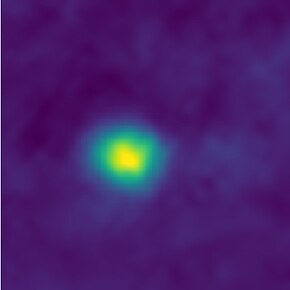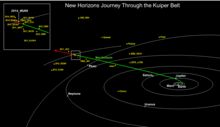2012 HE85
 | |
| Discovery[1][2] | |
|---|---|
| Discovered by | New Horizons KBO Search |
| Discovery site | Las Campanas Obs. |
| Discovery date | 18 April 2012 (first observed only) |
| Designations | |
| 2012 HE85 | |
| VNH0021[3] | |
| Orbital characteristics[4] | |
| Epoch27 April 2019 (JD2458600.5) | |
| Uncertainty parameter3[1] | |
| Observation arc | 5.18yr(1,892 d) |
| Aphelion | 49.639AU |
| Perihelion | 40.156 AU |
| 44.897 AU | |
| Eccentricity | 0.1056 |
| 300.84 yr (109,882 d) | |
| 12.220° | |
| 0° 0m11.88s/ day | |
| Inclination | 3.0161° |
| 234.99° | |
| 37.770° | |
| Physical characteristics | |
| 8.9[1][4] | |
2012 HE85is a small, resonanttrans-Neptunian objectfrom theKuiper belt,located in the outermost region of theSolar System,approximately 74 kilometers (46 miles) in diameter. It was first observed by a team of astronomers using one of theMagellan Telescopesin Chile during theNew Horizons KBO Searchon 18 April 2012, in order to find a potential flyby target for theNew Horizonsspacecraft.[1]The likely5:9 resonant objectwas imaged by the spacecraft from afar at a record distance from Earth in 2017.[7]
Orbit and classification
[edit]TheKuiper belt objectis considered to be aresonant trans-Neptunian objectin a higher5:9 orbital resonancewith the ice giantNeptune.[5][6]It orbits the Sun at a distance of 40.2–49.6AUonce every 300 years and 10 months (semi-major axisof 44.9 AU). Its orbit has aneccentricityof 0.11 and aninclinationof 3°with respect to theecliptic.[4]The body'sobservation arcbegins with its official first observation by David Osip,Paul Schechter,David Borncamp,Susan BenecchiandScott Sheppardof theNew Horizons KBO Search(268) using theMagellan II (Clay) telescopeat theLas Campanas Observatory,located in the Atacama desert in Chile.[1][2]
Milestone image
[edit]
When theNew Horizonsspacecraft imaged2012 HE85in 2017, it was the farthest from Earth ever captured by a spacecraft. The image was taken by the spacecraft'sLong Range Reconnaissance Imager(LORRI) on 5 December 2017 at more than 6.12 billion kilometers (40.9 AU) away from Earth. This record was previously held by theVoyager 1spacecraft which took the iconicPale Blue Dotimage at 6.06 billion kilometers from Earth in February 1990.[7]
In December 2017,New Horizonsalso imaged the classical Kuiper belt object(516977) 2012 HZ84,which was discovered by the same team of astronomers the night before they first observed2012 HE85.[7]Both objects held this record for little more than one year, until it was superseded on New Year's Eve 2018/19, whenNew Horizonsmade its close flyby on486958 Arrokothat a new record distance of 6.4 billion kilometers from Earth.[8]
Physical characteristics
[edit]According to Johnston's Archive, the object measures 74 kilometers in diameter based on an assumedalbedoof 0.09 and anabsolute magnitudeof 8.9.[4][5]Another estimates gives a smaller diameter of 31 kilometers due to an assumed albedo of 0.15.[3]As of 2019, no rotationallightcurveof2012 HE85has been obtained fromphotometricobservations. The body'srotation period,poleand shape remain unknown.[4]
Numbering and naming
[edit]As of 2019, thisminor planethas neither beennumberednornamedby theMinor Planet Center.[1]
References
[edit]- ^abcdefg"2012 HE85".Minor Planet Center.Retrieved4 January2019.
- ^abBuie, M. W.; Parker, A. H.; Tholen, D. J.; Borncamp, D. M.; Osip, D. J.; Schechter, P. L.; et al. (20 January 2016)."MPEC 2016-B36: 2012 HE85".Minor Planet Electronic Circular.2016-B36 (2016–B36).Bibcode:2016MPEC....B...36B.Retrieved4 January2019.
- ^abcd"2012 HE85".Las Cumbres Observatory – Minor planet follow-up portal.Retrieved4 January2019.
- ^abcdef"JPL Small-Body Database Browser: (2012 HE85)"(2017-06-23 last obs.).Jet Propulsion Laboratory.Retrieved4 January2019.
- ^abcdJohnston, Wm. Robert (7 October 2018)."List of Known Trans-Neptunian Objects".Johnston's Archive.Retrieved4 January2019.
- ^ab"Orbit Fit and Astrometric record for VNH0021".Southwest Research Institute.Retrieved5 January2019.
- ^abc"New Horizons Captures Record-Breaking Images in the Kuiper Belt".NASA.8 February 2018.Retrieved4 January2019.
- ^Wall, Mike (4 January 2019)."The Hunt Is On for Moons Around Ultima Thule".Space.com.Retrieved5 January2019.
External links
[edit]- The Deep Ecliptic Survey Object Classifications
- List of Transneptunian Objects,Minor Planet Center
- 2012 HE85atAstDyS-2, Asteroids—Dynamic Site
- 2012 HE85at theJPL Small-Body Database
